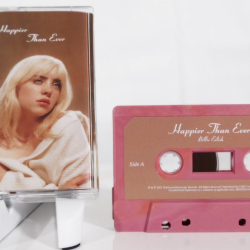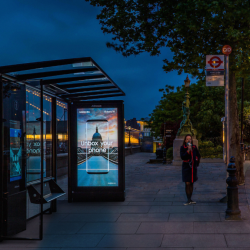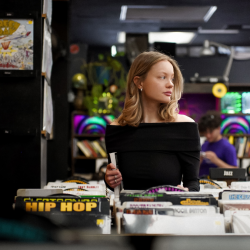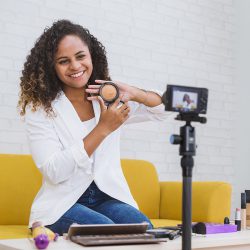While digital now accounts for more than half of UK ad spend, traditional media still remains very important and highly effective. In some cases, traditional platforms have been digitised, such as TV and radio. In others, analogue mediums have been reinvented by being combined with digital platforms. And sometimes it’s the original analogue medium that is still performing well against key deliverables.
Digital platforms and innovative tech-enabled media are great for precise targeting and measurement. They have become the bedrock of demand generation and product advertising. And in the current economic climate, with budgets as they are, it really makes sense for clients to be increasingly targeted in their media.
But this is only part of the story. Traditional media is still delivering in spades when it comes to awareness. And traditional media is still critical for brand advertising. You can just about pick any chart of Les Binet and Peter Field to see that traditional channels are more likely to produce large brand effects, drive long-term sales growth, deliver on creativity and boost emotion and fame — all of which perform on business metrics. It’s great to use the latest thing in media and as an industry we’re now driven by technology and innovation. But many of the latest platforms are entirely focused on close targeting based on an individual’s interest, consumption, behaviour and so on; and as a result can come at a higher cost.
And in doing this they often remove what we used to call ‘quality wastage’. Sometimes it’s important to use media that delivers bigger, less closely targeted audiences. If you’re only targeting an audience with an immediate need, you’re not addressing future potential audiences. This is what car brands have always done, on a large scale. So let’s look at some key areas of traditional media that are moving with the times, being given a new lease life or simply still performing exceptionally well.
Unlocking the new potential of out-of-home
Out-of-home is one of the oldest forms of media, and yet it continues to deliver. OOH opens up location-based targeting possibilities when used with mobile. And traditional OOH can still be cheaper and more effective than DOOH when driving brand awareness.
Advances in addressable technology now enable traditional OOH to work seamlessly with other digital platforms. We’ve seen great results from combining mobile with OOH. The two offer marketers a compelling combination of public and private screen, of broadcast and personal messaging. They enable brands to link people who have been exposed to both OOH — by targeting relevant mobile users at exact panel locations — and in-store advertising. The linking of the two exposures can be the tipping point for driving consumer action through sequencing of messaging and combined point-of-sale marketing. Mobile can also be used to complement OOH with immediate targeting against audiences exposed to an OOH ad, or by adding coverage to audiences not been exposed to OOH.
Direct mail becomes measurable and accountable
Direct mail is another age-old form of media, but it has been given a new lease of life with the integration of live marketing databases, using the kinds of data sources previously restricted to digital. This addressable element not only increases engagement through increased targeting relevance, but it also makes DM measurable, accountable and a strong acquisition channel.
For example, if an ecommerce home interest brand selling mosaic tiles is interested in targeting London homeowners with properties worth between £1m-£2m with a garden planning permission for an extension, there are data sources that will allow them to direct mail named individuals that fit these criteria. Any subsequent purchases can then be linked back to people who have received DM based on their names and addresses making this analogue channel highly measurable and accountable.
Radio continues to deliver big numbers
Unlike TV, radio is the one broadcast medium which still continues to deliver relatively big numbers across age groups. Yes, it’s digitised (with all the benefits of that) but it still performs and delivers as traditional platform. Commercial radio reaches nearly 70% of the UK population and over a third of weekly audio listening hours are consumed digitally (i.e. via DAB, apps or smart speakers as opposed to FM/AM). Commercial radio buys therefore reach broad audiences with average ages usually in the 40s, with CPMs in the low single digits.
And when brands want to be more specific in their audio targeting, streaming services such as Spotify offer much more granular targeting based on demographics, geography, interest, and content genres.
However, CPMs are in the double digits — often about four times more than commercial radio.
Print is great for high attention
While audiences have migrated to online content, print ads in newspapers and magazines still deliver on engagement. In fact, they represent somewhat of an ‘attention bargain’ in terms of cost per 1000 attentive seconds. According to Lumen, print ads are four times more likely of being noticed than online and have over 50% longer dwell time. However, print usually accounts for a small percentage of a news or magazine brand’s total reach. So while other forms of traditional media are bedrocks for broad reach awareness, print is great for niche, interest-led audiences. And this is then combined with digital to build audience scale.
All of this goes to show the value of traditional media. It is still incredibly important for reach, awareness and engagement. But in a world where digital is rightly king (and all innovation is tech-based) it’s about how you use traditional and analogue media in combination with digital that’s so important. It’s about taking a smart, real-world approach to media.
Featured image: Eric Nopanen / Unsplash































